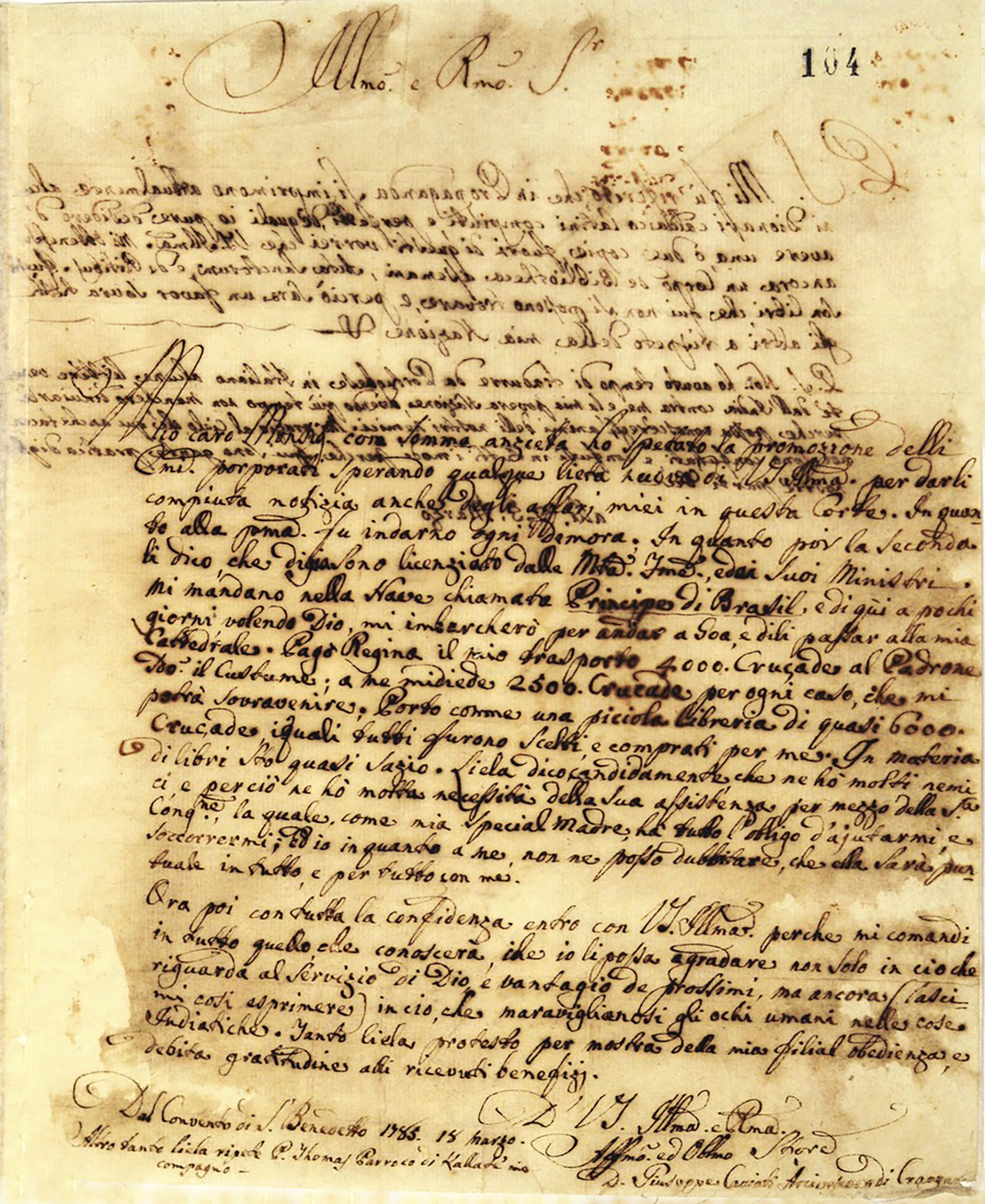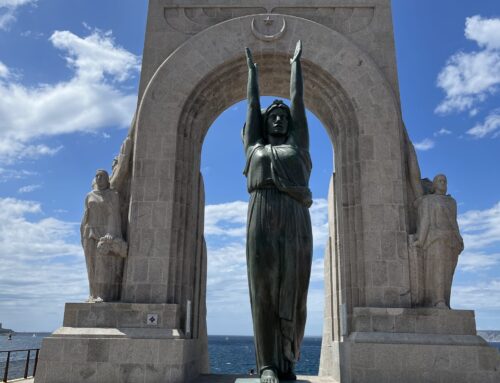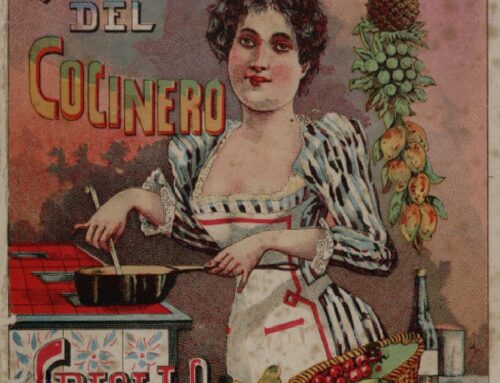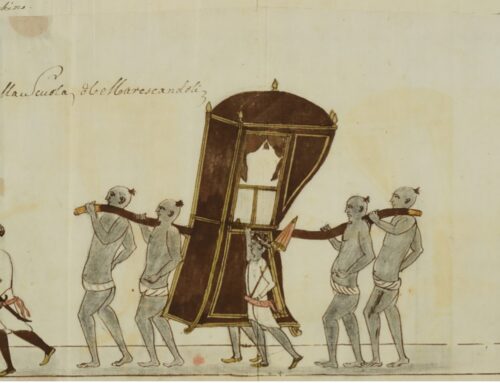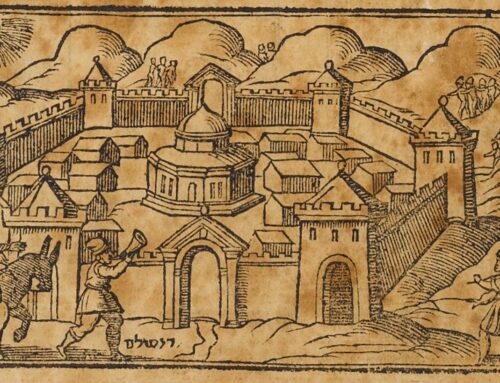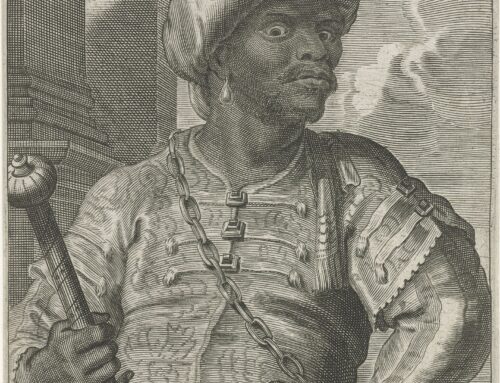December 1779. Four men from distant Kerala are waiting for quarantine clearance in Genoa after sailing from Lisbon on a ship belonging to Swedish merchants. Some six years later, a letter was sent by one of these men from Lisbon to the Propaganda Fide in Rome, just before embarking on a boat, destination South India. After exposing details about the logistics of the planned travel, the letter was also referring to a ‘small collection of books costing about 6000 cruçades’, about to be transferred with its owner to South India. Who were these men and what were they doing in the Mediterranean? What can we learn from this case as to the circulation of material and visual goods between India and Europe in that period? And what were the books in that ‘small collection’?
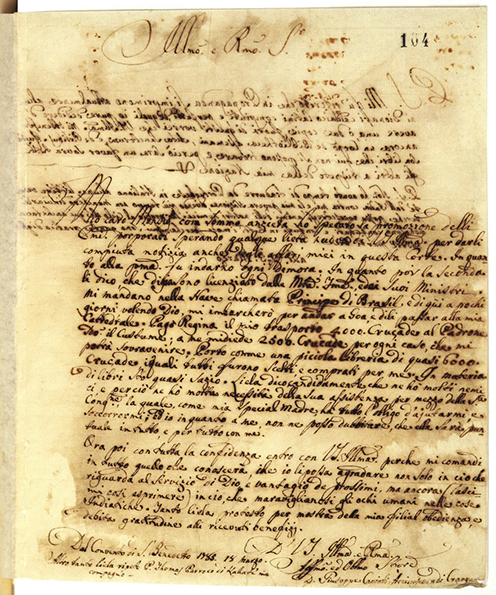
Figure 1: Last known letter of Kariyattil about his trip back to India, including a mention of a small collection of books worth of about 6000 cruçades that he took with him to India. The letter was sent to S. Borgia, secretary of the Propaganda Fide Congregation, in 1785. Source: Archives of the Propaganda Fide, Rome, Scritture riferite nei Congressi, Indie Orientali – Cina 38 Fol 104R, Copyright © Archivio Storico di Propaganda Fide
This story is told in a book written in Malayalam, the Varttamānappustakam [‘the book on various events’, further abbreviated VP], often hailed as the ‘first travel narrative in an Indian language’. In it, we read about the journey from Kerala to Rome in the years 1778 to 1786 of Mar Joseph Kariyattil (1742–1786) and his companion, a certain Paremmakkal Tomma Kattanar (1736–1799), proficient in a variety of languages including Syriac, Latin, Sanskrit and Malayalam, and the book’s author.
The general context is one of splits within the communities of Syriac Christians in India in the aftermath of the Synod of Diamper (1599) and the Coonan Cross Oath (1653), with some recognizing the missionaries’ authority and others rejecting it. Carmelite missionaries were sent to reunite the congregations, but the initiative did not have the intended effect. When multiple ‘councils’ failed to solve the situation, 72 churches or local communities sent two delegates to Lisbon and Rome, along with two young men who wanted to study at the Propaganda Fide Congregation in Rome. After tough negotiations (which in themselves show the complexity of organizing travels for reasons not directly related to trade or the military), the journey was undertaken on board of a ship, the Esperança, belonging to four Portuguese merchants specialising in the trade of clothes. It started out from Chennapattanam (modern-day Chennai) in November 1778. The route unsurprisingly followed Portuguese trade routes and the voyage is described as extremely unpleasant, even though the ship made two lengthy stopovers, in Benguela (Angola) and Bahia (Brazil), before reaching Lisbon on 18 July 1779. The Malabarians were struck by the city’s generally chaotic appearance, even though many of its roads were ‘orderly and straight.’ They were, understandably, particularly interested in describing buildings, people, events and sounds related to religion, for example, the number of churches, the sound of bells on festival days or the crowds of ‘religious people.’
The clerics had brought with them a few personal belongings and objects specifically acquired for the trip (shirts and blankets), money provided by local churches from alms or from the sale / mortgaging of church movables (!), as well as medicines from Malabar. They handed over a petition to the queen of Portugal, Maria I (1734–1816), advocating for the situation of the Syriac Christians in whose representation they had come, but since no resolution was made, they were advised to go to Rome. Once again, they had trouble securing a ship and asked a local merchant going by the name of Niccolò Corneli for help. In turn, he directed them to a Swedish captain named Israel Hedman – a name incidentally mentioned in another work, with regard to a discussion about the insured merchandise of a ship that had sailed from Sweden to Spain and Tunisia before sinking (see Emerigon 1783). After no fewer than 33 days of sailing, they arrived in Genoa where they observed a period of quarantine, a concept that the author thought remarkable enough to explain it to his audience:
In Genoa and in the other cities of Europe there are houses called Lazaretto which are intended for the safety of their citizens. The passengers of ships coming from the country of the Turks or from countries suspected of contagious diseases, or any cases of suspected diseases, are forbidden to enter the cities for about 40 days, the time for clearing off the suspicion. (VP, p. 118)
The Malabarians commented on the city, in particular its political administration and osterias. They also met a prominent member of the aristocracy, Marquise Negroni, probably Marianna Negroni Rivarola, the mother of the future cardinal Agostino Rivarola (1758–1842), who specifically asked for Indian drugs after mentioning that Jesuits coming from the same regions often brought them with them. Kariyattil gave her some drugs called vayugulika – an ayurvedic remedy for breathing troubles, based on a combination of spices, in particular ginger and pepper, still found today. The two clerics left Genoa for Rome on a small boat and reached Levanto in December 1779 where they were shown writings of Henry VIII against Martin Luther – probably the monarch’s treatise on the sacraments and his subsequent letter to Luther. From there, they took the land road to Pisa, Florence and Siena. They stopped in Viterbo where they visited the shrine to Santa Rosa and looked at her perfectly preserved body. (Fig. 2)
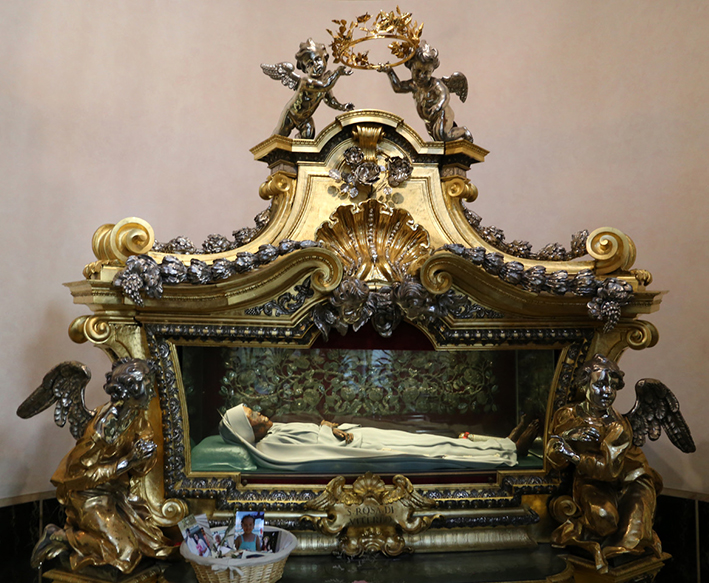
Figure 2: The body of Santa Rosa, Viterbo. Source: Wikimedia, https://upload.wikimedia.org/wikipedia/commons/3/38/Viterbo%2C_santuaro_di_santa_rosa%2C_interno%2C_corpo_di_rosa_da_viterbo_01.jpg
The body of the saint was dressed in a very precious gilded habit and was laid on silk cloths with a silk pillow over a low gilt couch. The head was covered with a white cloth and it looked like the head of our women when they put on the veil with folds. … The religious who opened the door of the place where the holy remains rested gave us four threads of cloth that had touched the holy body. (VP, p. 130)
What they saw in Viterbo was clearly not exceptional to them, and they shared a similar religious language in which the visual dimension is essential – one may think of the popular visits to saints’ tombs in India and on the importance to obtain darśan from saints and deities – probably hoping that it would have a positive effect on their mission’s outcome.
In Rome, they were received by Stefano Borgia (1731–1804), the secretary of the Propaganda Fide Congregation, who was quick to demonstrate his hostility. The visit to Rome obviously included a tour of religious monuments such as the Church of Saint Peter with his tomb, the Church of Santa Maria Maggiore, but also the Colosseum, which ‘in the pagan days [was] the place for meetings and sport. Now the devotional practice known as the way of the cross is held in it’ (VP, p. 171). The main purpose of the visit was, however, to take action to defend the interests of the Indian Syriac Christians. After several disappointments, they finally met the pope, Pius VI (1717–1799) in a meeting that led to the following curious exchange:
We saw the Pope sitting on a chair behind the door of this hall. There were on the table in front of the Pope two lighted candles fixed on silver stands. The body of the Pope was tall and stout, his face bright, his hair well combed and their [sic] ends arranged into curls like rings. As soon as we entered the room and saw the Pope, we knelt down and bowed three times and kissed his foot as we bow before the crucifix on Good Friday. … The Pope was very pleased and asked us who was the king in Malabar, whether he in any way persecuted the faithful, whether the climate of the country was agreeable, whether there was good fish there etc. (VP, pp. 151–2)
Indeed, instead of addressing the issues of the visitors’ concern, the pope is described as more interested in getting information on these remote and exotic lands (whereas one might have expected that he had all this information already). In that way the pope refused to enter into the matter and arbitrate the conflict between the Carmelites and the Syriac Christians of Malabar, to the great disappointment of the two delegates:
We endured afflictions and sorrows along a long journey and reached Rome and gave into the very hands of the Pope the petitions meant for procuring unity and other benefits for the Malabar Church … – all clearly written down and splendidly bound together as a book. We were able by the grace of God to implore the Pope to read them himself and give a reply. But as the result of a quarter-of-an-hour’s suggestions, the Pope did not read them nor even open them, but gave them to Msgr. Borgia our enemy (VP, p. 153).
Before leaving Rome, the delegates received money from the Propaganda Fide to pay for their journey back to Portugal, as well as gifts – two gold crosses and laudatory letters from the pope for friends of Borgia in Malabar.
They returned from Rome to Lisbon where they stayed for several years, retained by religious authorities influenced by the Goa clergy who were afraid that if the delegates returned to India, it would cause unrest. During their time in Lisbon, they were presented with some books in Malayalam:
While we were in Lisbon … there was found a box of books in Malayalam characters. The people of the place did not know where these characters were in use and who the owner of the box was. … The next day the Malpan [i.e. Kariyattil] accompanied Louis Antony and found out they were books on Theology printed in Malayalam and sent from the Propaganda. (VP, p. 198)
Since the journey took place in the years 1778–1786, the ‘books on Theology printed in Malayalam’ must have included the Saṅkṣēpa Vedārtham [an abridgement of the Bible], the work of the Carmelite missionary Clement Pianius (1714–1782) who had spent many years in Kerala. It was a condensed version of the New Testament written in the form of a dialogue between a guru and his disciple, and the first text printed using Malayalam movable types in Rome, as early as 1772. The way this ‘box of books’ is mentioned suggests that these printed texts were of quite marginal importance. Despite the technical prowess of printing Malayalam and Latin script on the same page, the dissemination of such texts out of Rome seems to not have been as efficient as a production and distribution directly on site.
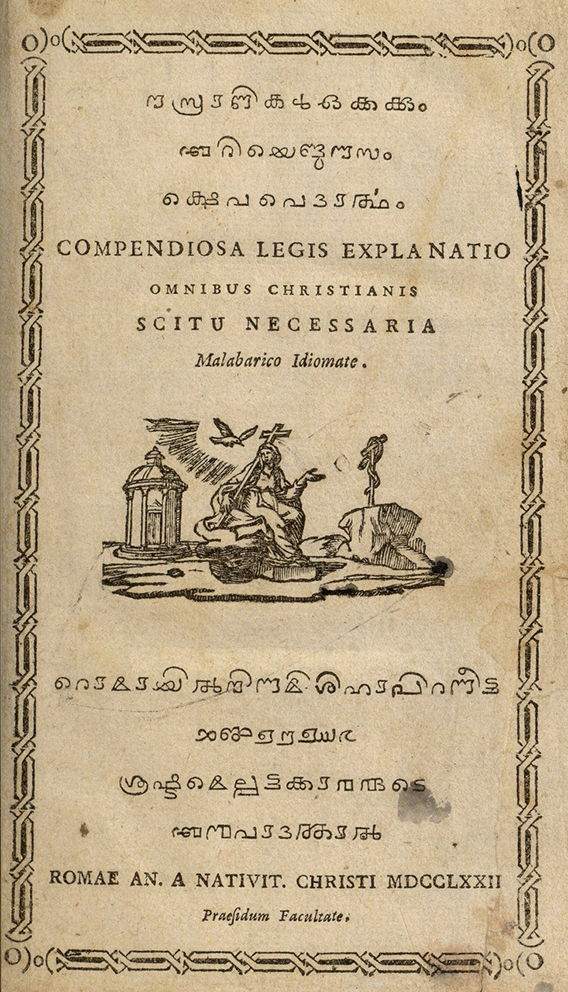
These were not the only books Kariyattil brought back to India. As we mentioned earlier, he explicitly wrote about a ‘small collection of books’, bought in Portugal and transported to South India. As to what books might have been in that collection, a list of Kariyattil’s belongings redacted in September 1786, three months before his death, mentions several ‘European’ books. Some of them would typically be held in a Roman Catholic seminar, such as a multilingual Bible or the Benedictine Augustin Calmet’s French commentary on the Bible. Others were less common or even controversial, such as works by the Jansenist Zeger Bernard Van Espen (1646–1728) or by Johann Nikolaus Von Hontheim (pseud. Febronius, 1701–1790), a proponent for a more democratic church and critic of papal supreme authority.
Eventually, in virtue of the Padroado system, the Portuguese queen appointed Kariyattil archbishop of Cranganore. This was a political move by the Portuguese Crown in order to increase its influence in India, in the context of competition between the Padroado regime and the Roman Propaganda Fide: Kariyattil’s appointment would reduce the influence of the latter. The clerics were finally able to leave Lisbon for Bahia in April 1785 on a ship carrying 300 convicts. They arrived in Kerala in the summer of 1786 on the same ship, after 23 of the convicts had died on board. The text is abruptly interrupted when they are in sight of Sri Lanka. We know, however, from other sources that Kariyattil died in December 1786 in Goa, before he could actually take up his new position, thus putting paid to the Portuguese intentions in appointing him to this role.
This case study sheds light on the role of the Mediterranean space within a ‘global Christian network,’ seen from an external perspective: for the book’s author, Europe was evidently Roman Catholic and its centres were Lisbon and Rome, while both the Padroado regime and the Propaganda Fide congregation were seen as sources of authority. The most remarkable goods that are shown circulating here are books and drugs – not to mention, of course, the more usual products of spices and textiles, only incidentally mentioned by the text. The text signals the intention of its author to offer its audiences a rather detailed account of these remote lands, perhaps out of the concern to show accountability to communities that had funded the trip, but not without adding ‘picturesque’ details that make the narrative more compelling (in a way that is reminiscent of European travel accounts of the same time). Finally, the case study displays both the mechanics of communication across the cultural diversity of the Mediterranean space in this period, and the deliberate and intricate ways to not understand interlocutors from remote lands in order to safeguard religious and political interests.
Note on the sources
The book was translated into English by Placid J. Podipara, on the basis of an edition prepared in 1936 for the 200th anniversary of Paremmakkal’s birth. A new Malayalam edition was released by Mathew Ulakamthara, Varthamana Pusthakam athava Roma Yathra. Kottayam: DC Books, 1983. A full reproduction and translation of the 1785 letter is available in Payngot 1987, pp. 171–173. The 1786 list is mentioned in Hambye 1987 and is kept in the State Archives at Panaji (HAG MR 166 ff 32r–69r).
Further reading
Bayly, Susan, Saints, Goddesses and Kings: Muslims and Christians in South Indian Society, 1700–1900, Cambridge: Cambridge University Press, 1900.
Coates, Timothy J., ‘The Portuguese Empire, 1100–1932,’ in A Global History of Convicts and Penal Colonies, ed. Clare Anderson, London: Bloomsbury Academic, 2018, pp. 37–64.
Cosme, Jose Costa, A Missiological Conflict Between Padroado and Propaganda in the East, Pangim: Pilar Publications, 1997.
Emerigon, Balthazard-Marie, Traité des assurances et des contrats à la grosse, Marseille: Jean Mossy, vol. 2, 1783.
Hambye S. J., E. R., ‘Mar Joseph Cariattil between Propaganda and Padroado,’ in Payngot, Charles (ed.), Homage to Mar Cariattil: Pioneer Malabar Ecumenist. Rome: Mar Thoma Yogam, 1987, pp. 51–57.
Müller, Leos, ‘Swedish Trade and Shipping in the Mediterranean in the 18th Century,’ in Reti marittime come fattori dell’integrazione europea, Florence: Firenze University Press, 2019, pp. 453–69.
Patterson, T. J. S., ‘The Relationship of Indian and European Practitioners of Medicine from the Sixteenth Century,’ in Indian Medical Tradition, vol. V: Studies on Indian Medical History, ed. G. J. Meulenbeld and D. Wujastyk, Delhi: Motilal Banarsidass, 2001.
Payngot, Charles (ed.), Homage to Mar Cariattil: Pioneer Malabar Ecumenist. Rome: Mar Thoma Yogam, 1987.
Subrahmanyam, Sanjay, ‘Dom Frei Aleixo de Meneses (1559–1617) et l’échec des tentatives d’indigénisation du christianisme en Inde,’ Archives de Sciences sociales des Religions 103 (1998), pp. 21–42.
Thomman Cathanar, Paremmakkal, tr. Placid J. Podipara, The Varthamanappusthakam, Rome: Pont. Institutum Orientalium Studiorum, 1971 (=VP).
Biography
Philippe Bornet is Senior Lecturer at the Interdisciplinary Centre of Religious Studies (CIHSR), in the Department of South Asian Languages and Civilizations of the University of Lausanne. His current research deals with interactions between India and Europe and, more specifically, Swiss missionaries in South India and the circulation of epistemic and visual cultures. His recent publications include Translocal Lives and Religion: Connections between Asia and Europe in the Late Modern World (2021) and, with Claire L. Blaser and Maya Burger, Interweaving Histories. Itineraries between Switzerland and India (1900-1950) (2023).


